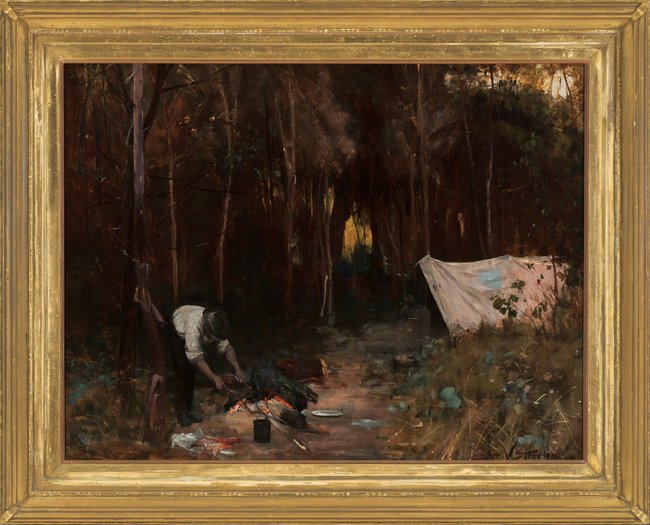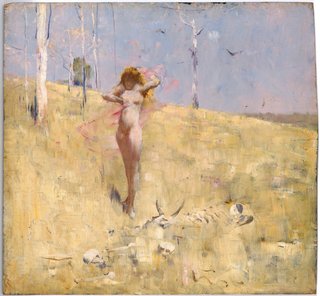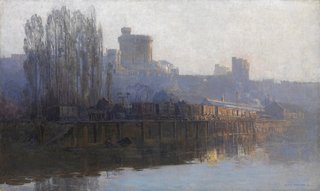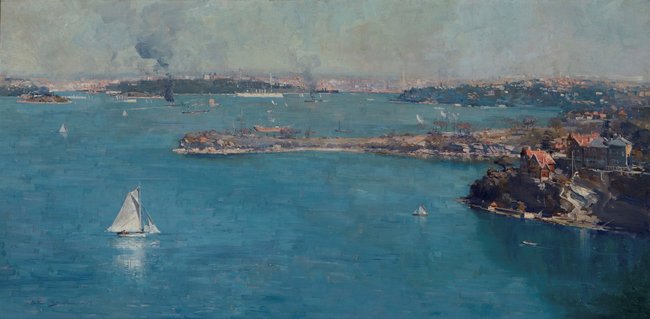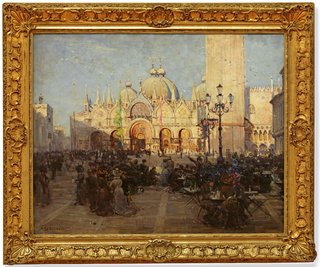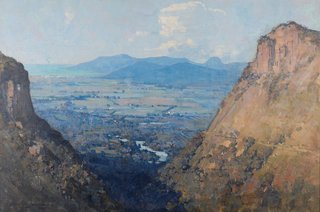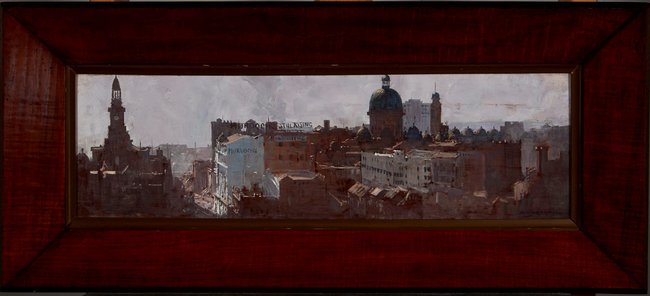Art Sets.
Streeton: children’s labels
Print this setBy the Art Gallery of NSW
Uploaded image
PRIVATE COLLECTION Arthur Streeton Settler's camp 1888
Have you ever been camping in the bush?
This man has made a campsite at the edge of some trees. His simple tent looks like a piece of canvas slung over some branches. If you look closely, you can see the last of the day’s sunlight in the clearing in the distance. Can you spot the man’s axe and a shovel leaning against a tree? What do you think he needs those for? The man is bent over his campfire, carefully lifting the black can, or billy, off the fire.
What do you think he’s made to eat or drink?
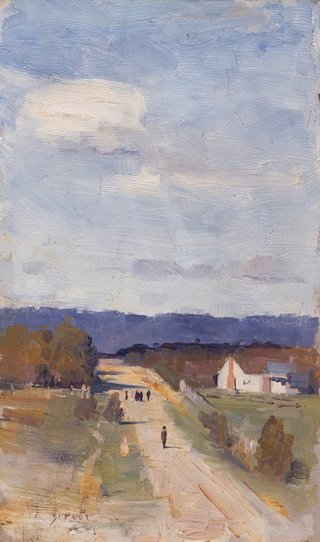
AGNSW collection Arthur Streeton A road to the ranges 1889
Do you like gazing up at clouds and the fluffy forms they create?
The sky takes up over half of this small painting. Our eyes are drawn up the road towards the sky, with its billowing clouds and shafts of light. The mountain range in the background has become a simplified purply-blue shape and the trees, houses and figures are painted with sweeping brushstrokes. Painted on the spot, this picture captures the fleeting light that played across the landscape with soft shades of colour.
If you were standing on this road, what do you think you would see in the opposite direction?
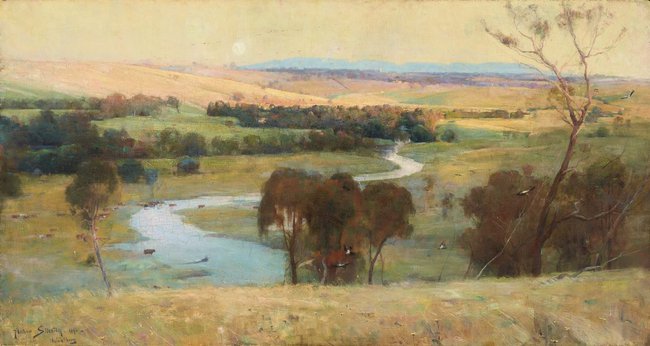
AGNSW collection Arthur Streeton 'Still glides the stream, and shall for ever glide' 1890
Read the title of this painting. Do you think it suits the scene?
The title is taken from a famous poem. Streeton liked the idea of his art lasting beyond his lifetime. Do you feel like you are standing with Streeton on a ridge, looking down on the river as it winds and glides through the valley? Each zigzag of the river draws our eyes to a different part of the landscape. We are led from the trees to the grazing animals, to the hills and the disc of the moon. The soft colours and light express the beauty of nature and create a sense of peace.
How many little black-and-white birds can you spot?
Uploaded image
NATIONAL GALLERY OF VICTORIA COLLECTION Arthur Streeton Circular Quay 1893
Notice the long, thin shape of this painting.
This harbour scene of Circular Quay in Sydney is painted on a strip of wood that was once used to hold a roll of fabric. Streeton was a keen recycler and often painted on surfaces that had been used for something else before. Sometimes he even painted over his own artworks. The long, thin format is almost like we are peeking through a window slit or a gap in some railings, watching the ferries and boats chug from dock to dock.
How different does the skyline look compared to Sydney today? What landmarks are missing?
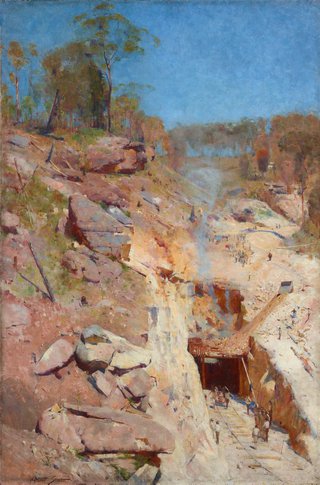
AGNSW collection Arthur Streeton Fire's on 1891
Imagine yourself on this rocky hillside.
‘Fire’s on!’, shouts a workman. Then, ‘Boom!’, dynamite blasts the rocks in the tunnel and shakes the ground. Only this time, something has gone horribly wrong. Can you see a man being carried out of the tunnel on a stretcher? Pale, blue smoke swirls up as some figures in the distance run to see what’s happened.
Streeton actually experienced this event as he was painting. How do you think he felt?

AGNSW collection Arthur Streeton The railway station, Redfern 1893
What sounds would you hear if you stepped into this painting?
Even though this is a painting of Redfern Station, the wet surfaces, puddles and watery shadows are the real subject matter. The bustle and activity of the station is all in the background. The wet-looking paint creates a cold and windy atmosphere, with little figures darting across the street or bracing themselves against the weather. We can almost feel the rain and the wind as the steam from the trains rises and blends into the misty sky.
What different types of transport can you spot?
Uploaded image
NATIONAL GALLERY OF AUSTRALIA COLLECTION Arthur Streeton The spirit of the drought c1896
Do you believe in fairies, spirits or angels?
This painting depicts an imagined fairy-like creature that symbolises the destruction caused by drought and fire. When Streeton painted this over 100 years ago, artists and writers invented female figures like this spirit to tell stories or warn against thoughtless and careless behaviour.
Describe the different ways Streeton suggests the heat of this landscape. What time of day do you think it is?
Uploaded image
PRIVATE COLLECTION Arthur Streeton Minarets, Cairo 1897
Do you love visiting new places?
Like many artists of his time, Streeton travelled overseas to explore new places. This painting captures the atmosphere and sights of Cairo in Egypt. The tall, decorative towers in the background almost look as if they are made of icing sugar. A busy market is being held under the archway and canopies, where people wearing blue robes gather.
Imagine the sounds you would hear. What would be the loudest?
Uploaded image
NATIONAL GALLERY OF VICTORIA COLLECTION Arthur Streeton Windsor c1904
Do you know who lives in this castle?
This is Windsor Castle, home to the British royal family. Streeton has painted the castle as a shadowy silhouette in the background. He has chosen to focus on the River Thames and the detail of a steam train pulling into the station. Notice at all the vertical lines created by the train carriages, the embankment, the castle, the tall poplar trees and the chimneys of the town.
How many chimneys can you find?
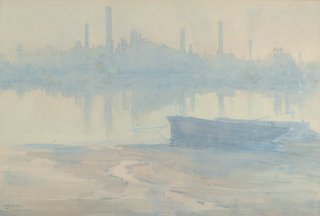
AGNSW collection Arthur Streeton Morning mist on the Thames circa 1906
Have you ever experienced mist or fog? How far could you see?
The shapes of this skyline are just visible through the misty light and they are reflected in the glassy surface of the river. The dark silhouettes of some boats sit on the muddy edge of the river. The tide is out and a little stream of water winds through the mud. The quickly applied lines of watery paint define its path.
Can you spot Streeton’s signature on the painting?
Uploaded image
PRIVATE COLLECTION Arthur Streeton Sydney Harbour 1907
How many shades of blue can you see in this painting?
Streeton painted this outdoors, standing near where Taronga Zoo is now. The curved shoreline of Cremorne and the many inlets of crystal blue water weave in and out of the harbour. Streeton shows it as a bustling place, full of steamers and ferries and activity. In December 1907, The Sydney Morning Herald reported that over 10,200 vessels had entered Sydney Harbour that year.
Imagine you are sailing into the harbour for the first time. What things would catch your attention?
Uploaded image
QUEENSLAND ART GALLERY COLLECTION St Mark's, Venice 1908
Do you recognise this famous Italian city?
This is St Mark’s Square in Venice. The people sitting in the open-air cafes are shrouded in shadow, while the splendour of the architecture in the background is captured in bright light. Streeton has ‘cut off’ the spire at the top of Venice’s famous bell tower, or Campanile. Or has he? The centuries-old tower collapsed in 1902 and when Streeton painted this in 1908 the rebuilding was not complete. The picture also shows us what fashions were like in the early 1900s. Notice the style of the ladies’ dresses.
Who is wearing the fanciest hat?
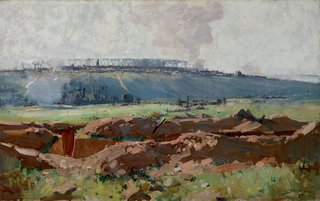
AGNSW collection Arthur Streeton Villers-Bretonneux 1918
Did you know Streeton became an official war artist in 1918, toward the end of the First World War?
During that war, some of the heaviest fighting took place in the Somme Valley in France. Streeton toured the area and painted what he saw and experienced. Here we see a battlefield and the top of a trench – a deep channel dug into the ground where soldiers sheltered from gunfire. The high sides of the trench were supposed to protect the soldiers, but this picture suggests at least one of them has been unlucky.
Can you see the legs of the poor soldier in the mud?
Uploaded image
ART GALLERY OF WESTERN AUSTRALIA COLLECTION Arthur Streeton The Barron Gorge and sugar plains 1924
Imagine flying into this landscape.
The viewpoint of this gorge in far north Queensland creates the illusion that we are flying high in the sky looking down on the land below. Barron Gorge is a protected area near Cairns known for its deep gorges and waterfalls and wet tropical climate. When Streeton painted this landscape, the area was used for growing sugarcane because it needs wet, fertile soil to grow. The flat areas in the distance are the sugar plains that are named in the title.
Can you spot any evidence of human interaction with this landscape?
Uploaded image
PRIVATE COLLECTION Arthur Street Town Hall and domes of the market 1921
Count the domes and towers in this painting of Sydney’s skyline.
When Streeton returned to Australia after his time as a war artist in Europe, he noticed how much the city of Sydney had changed. Apartment blocks and tall buildings had been built as the city grew and became more modern. In this view of Town Hall and the Queen Victoria Building, Streeton experiments with an elevated view of the rooftops. He has painted the scene from a window high up in a building.
Can you make out what the signs say on the buildings?
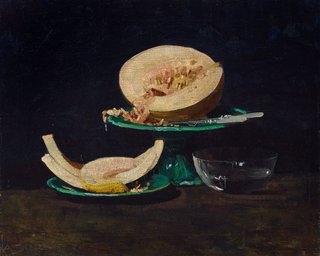
AGNSW collection Arthur Streeton The melon circa 1920
This painting of a melon has a secret.
Streeton has painted the scene in a realistic manner. Notice the highlights of light on the shiny glass bowl and the intricate detail of the seeds inside the melon. But hidden behind this juicy looking fruit is a painting of a landscape that Streeton made in England a few years earlier. The Gallery’s conservation team made this exciting discovery using an X-ray machine. They investigated Streeton’s paintings and found that he often painted over old paintings.
Can you see any trace of what was in the original painting?
